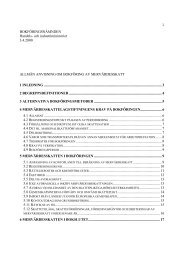Knowledge Intensive Services' Suppliers and Clients
Knowledge Intensive Services' Suppliers and Clients
Knowledge Intensive Services' Suppliers and Clients
You also want an ePaper? Increase the reach of your titles
YUMPU automatically turns print PDFs into web optimized ePapers that Google loves.
23<br />
coefficients – shifts in economic activity which increase the dem<strong>and</strong> for these<br />
services as contributors to final products. In other words, KIBS are becoming more<br />
significant elements in the activities of the whole economy. Table 3 demonstrates<br />
that business services also contribute to other services’ activities in the Dutch<br />
economy.<br />
2.1.3 Economic performance<br />
Several studies have used macro-data to throw light on the relations between KIBS<br />
use <strong>and</strong> the economic performance of these users. 8 These studies work with<br />
statistics representing economic sectors, <strong>and</strong> the hypotheses tested are that there is a<br />
correlation between the use of KIBS inputs across sectors (given from IO data) <strong>and</strong><br />
the performance of these sectors. (Thus what is tested is the notion that sectors<br />
whose firms have a high level of KIBS use are sectors with better than average<br />
performance – though we can only infer that this performance actually derives<br />
from the KIBS-using firm.) Measures of performance may be such indicators as<br />
growth <strong>and</strong> productivity growth rates. We consider two variants of this approach<br />
below.<br />
A cluster analysis of service inputs<br />
Peneder et al (2001) 9 seek to assess the effects of external service inputs on the performance<br />
of EU manufacturing. They use statistical cluster analysis methods to develop<br />
a taxonomy of (manufacturing) sectors based on their use of different service<br />
inputs. However, the data source employed for this is US IO tables for 1992, due to<br />
the lack of precision of large-scale EU data sets. There is a rather bold assumption<br />
8 The issue here is how KIBS contribute to the performance of their users – not how the performance of<br />
KIBS contributes to the average performance of all economic sectors. Baker et al (2002) provide an<br />
example of the latter type of approach. They analyse the labour productivity growth in market<br />
services for 9 EU Member States, the USA <strong>and</strong> Japan., <strong>and</strong> also calculate the contribution made by<br />
market services to aggregate labour productivity performance. The OECD’s STAN database<br />
provided the data used here. The researchers depicted a low rate of (measured) productivity growth<br />
<strong>and</strong> strong employment growth in business services. Divergent trends seemed to emerge in the EU<br />
<strong>and</strong> US – the EU’s superior performance in the earlier period (in employment <strong>and</strong> especially in<br />
productivity growth) is overtaken by that of the US in subsequent years. This finding is now fairly<br />
well known (<strong>and</strong> much argued over) for the economy as a whole. If reliance can be placed on the data<br />
(<strong>and</strong> there is a strong line of critique of the adequacy of productivity indicators for services) it raises<br />
the question of how these services’ performance is affecting their contributions to their clients, <strong>and</strong><br />
thus their clients’ performance.<br />
9 Peneder M., S. Kaniovski <strong>and</strong> B. Dachs (2001) “External services, structural change <strong>and</strong> industrial<br />
performance”, Enterprise Papers No. 3, European Commission – DG-Enterprise.
















